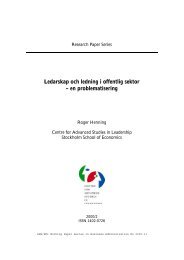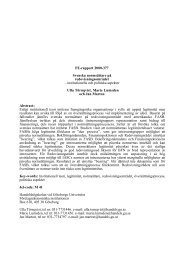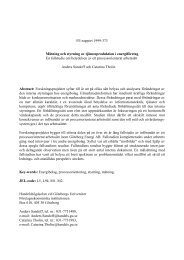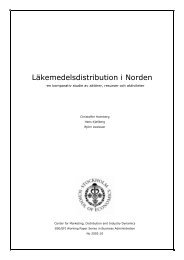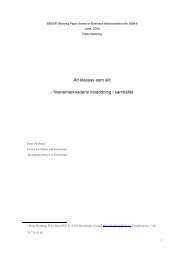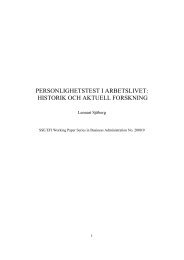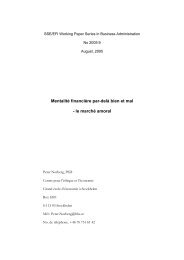Big Five Plus - S-WoBA - Handelshögskolan i Stockholm
Big Five Plus - S-WoBA - Handelshögskolan i Stockholm
Big Five Plus - S-WoBA - Handelshögskolan i Stockholm
Create successful ePaper yourself
Turn your PDF publications into a flip-book with our unique Google optimized e-Paper software.
88. Havaleschka, F. (1999). Personality and leadership: a benchmark study of success and<br />
failure Leadership and Organization Development Journal, 20(3), 11-13.<br />
89. Hayman, J. (2005). Psychometric assessment of an instrument designed to measure work<br />
life balance. Research and Practice in Human Resource Management, 13(1), 85-91.<br />
90. Heatherton, T. F., Wyland, C. L., & Lopez, S. J. (2003). Assessing self-esteem. In C. R.<br />
Snyder (Ed.), Positive psychological assessment: A handbook of models and measures.<br />
(pp. 219-233). Washington, (pp. 219-233). Washington, DC: American Psychological<br />
Association.<br />
91. Heggestad, E. D., Morrison, M., Reeve, C. L., & McCloy, R. A. (2006). Forced-Choice<br />
Assessments of Personality for Selection: Evaluating Issues of Normative Assessment<br />
and Faking Resistance. Journal of Applied Psychology, 91, 9-24.<br />
92. Hellgren, J., Sjöberg, A., & Sverke, M. (1997). Intention to quit: Job satisfaction and job<br />
perceptions. In F. Avallone, J. Arnold & K. de Witte (Eds.), Feelings work in Europe,<br />
Vol. 5 (pp. 412-423). Milano: Guerini Studio.<br />
93. Helson, R., Kwan, V. S. Y., John, O. P., & Jones, C. (2002). The growing evidence for<br />
personality change in adulthood: Findings from research with personality inventories.<br />
Journal of Research in Personality, 36(4), 287-306.<br />
94. Heneman, H. G. (1974). Comparisons of self- and superior ratings of managerial performance.<br />
Journal of Applied Psychology, 59(5), 638-642.<br />
95. Herscovitch, L., & Meyer, J. P. (2002). Commitment to organizational change: Extension<br />
of a three-component model. Journal of Applied Psychology, 87(3), 474-487.<br />
96. Hicks, L. E. (1970). Some properties of ipsative, normative, and forced-choice normative<br />
measures. Psychological Bulletin, 74, 167-184.<br />
97. Higgins, E. T., Friedman, R. S., Harlow, R. E., Idson, L. C., Ayduk, O. N., & Taylor, A.<br />
(2001). Achievement orientations from subjective histories of success: Promotion pride<br />
versus prevention pride. European Journal of Social Psychology, 31(1), 3-23.<br />
98. Hoffman, C. C., Nathan, B. R., & Holden, L. M. (1991). A comparison of validation criteria:<br />
Objective versus subjective performance measures and self- versus supervisor ratings.<br />
Personnel Psychology, 44(3), 601-619.<br />
99. Hoffmann, R. M., & B. (1995). Silent rage: Passive-aggressive behavior in organizations.<br />
ProQuest Information & Learning: US.<br />
100. Hofstee, W. K. B., Collis, J. M., & Messick, S. (2001). Intelligence and personality: Do<br />
they mix? In J. M. Collis & S. Messick (Eds.), Intelligence and personality: Bridging<br />
the gap in theory and measurement. (pp. 43-60): Lawrence Erlbaum Associates Publishers:<br />
Mahwah.<br />
157



